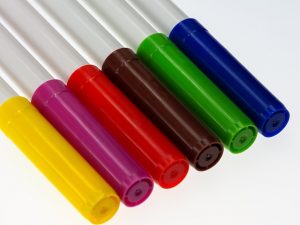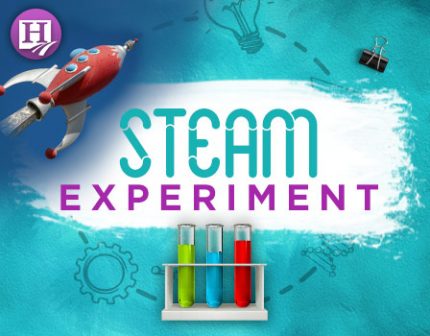There are many reasons some kids hate science. But, it is possible to inspire a love of science in these kids with carefully selected lesson plans and experiments. Here are three science-based lesson plans for kids who hate science. I hope that these activities will turn around kids’ attitudes toward such an important (and fun!) subject.
Mystery Markers
One of the best ways to inspire kids who hate science is to show them the science of everyday objects, such as markers. Kids may not realize that most colors are composed of several different dyes. For the Mystery Markers lesson, you’ll need a bowl of clean water, strips of paper towels, and markers of 3 or more different colors (try to include black and non-primary colors, such as orange). 
Have your child draw a wavy line about an inch from the bottom of a paper towel strip with one marker. Repeat using a new strip with each color until the child has used all of the colors. Ask the child to make a hypothesis about what will happen when he dips the strip into the water.
Next, instruct the child to dip a strip into the water so that the paper towel’s bottom edge is submerged, but not the wavy ink line. The child should hold the strip in place until the water begins to absorb into the towel, making the ink mark spread. Have the child observe the strip and note his observations. Then, ask the child to make a new hypothesis for the remaining strips. Finally, repeat the dipping process with each strip. The child will see that the various dyes in each color are revealed.
Explain that the water molecules bond with the ink molecules, spreading them out on the paper towel. This process of separating the dyes, as with separating the components of any mixture, is called chromatography. To extend the lesson, dip strips ahead of time and have the child guess which marker was used.
Transparent Plants
Some kids hate science because they can’t visualize the concepts. One science-based lesson plan for kids like this is Transparent Plants. Transparent Plants is a fun and easy way to teach the plant lifecycle and parts of plants to elementary-age children.
You’ll need CD cases, potting soil, water, and lima beans. First, have the kids fill the CD case with a little potting soil. Be sure the hinges of the CD case are at the top, so they will stand up without allowing the dirt to fall out. Next, plant the bean high in the soil, so the roots will not grow out the bottom, and tape the bottom shut. Use a water dropper to water the bean through the opening at the top of the CD case and place it in the sunlight.
Kids will observe the plant grow, and they should measure its growth and record the changes they observe in their plant every few days. It’s also helpful to supply the children with journals or bean growth sheets so they can easily track the plant’s growth. After about a week, give the students markers or paint pens to label the parts of the plant directly on the CD case.
To extend this science-based lesson, you can turn it into an experiment by asking children to plant some beans with the concave side down, to make a letter “n,” and some beans with the concave side up, to make a letter “u.” Kids can then compare the growth of their beans and discuss the differences in their plants, based on how they oriented their bean when they planted it.
The Physics of Pool Temperatures
Science lessons don’t have to take place solely in a classroom setting, and one of the best ways to get kids excited about the subject is to head to every kid’s favorite spot: the swimming pool. It’s best if you can get to a large pool, though this lesson can be adapted for a kiddie pool. Grab paper and pencil, your bathing suit, appropriate safety gear, sunscreen, towels, a pool thermometer, and a couple pairs of goggles to learn about the Physics of Pool Temperatures. (Don’t be afraid to make adjustments depending on your child’s swimming abilities!)
If possible, first visit the pool in the morning to stick your toes in the water and check the temperature. Have your child record the time, outside temperature, and water temperature on a piece of paper.
Return to the pool in the afternoon when the sun has had some time to shine. Test the water again and record the time and temperature. Next, jump right in! Swim around to different depths and see how the temperature varies. Using your goggles, swim to the deepest section of the pool and check the temperature. Record all the information you gather. If you’re at a public pool and there’s a child’s pool present, compare the differences in temperature between the large and small pools. Discuss thermodynamics and why different volumes and levels of water may differ in temperature, as well as how the sun and time of day affects it.
By using common objects and showing kids the science that is around them in everyday life, you most likely will spark their interest in science. The more fun science activities you conduct with them, the more they will use their natural curiosity to ask questions, make hypotheses, and want to know why things work in the ways that they do. In the process, you may just inspire a love of science in the kids who hate it.
Jamie Strand is a former homeschool kid and unashamed science nerd. He’s a community college professor and proud father of two daughters who wants to inspire a passion for science and math in today’s young people. That goal drove him to start SciCamps.org with help from a good friend. When he isn’t teaching, Jamie can often be found digging for fossils in the backyard with his daughters, exploring the local nature preserve, or binge-watching Star Trek reruns.
More Homeschool Science Resources!
- Summer Science: SLIME Recipes Your Kids are Sure to Love!
- Gummy Bear Osmosis Science Experiment
- Soggy Cereal Fun Science
- Science Experiments for Kids Who Hate Science
Image via Pixabay
Latest Posts

Guest Post by Gabriel Morse For several years, I sat for long hours every day behind one of those battleship gray desks in a windowless, dull, gray office. The pay was enough to take care…
Read more >
This post is sponsored by Little Monsters Universe. I'm Tina Salmanowitz, an advocate for homeschooling and science education. With over a decade of experience as a science educator (in class…
Read more >
This post is sponsored by Time4Learning. Before the pandemic, it was business as usual for Boca Raton resident Nikki Warris. Her two daughters, 5-year-old Natalie and 8-year-old Lexi were…
Read more >


